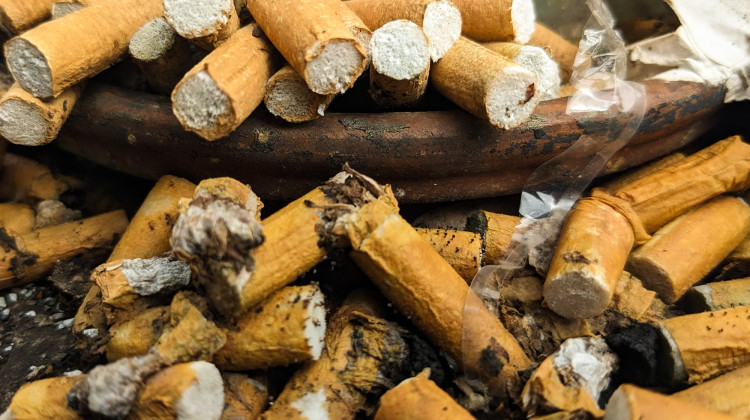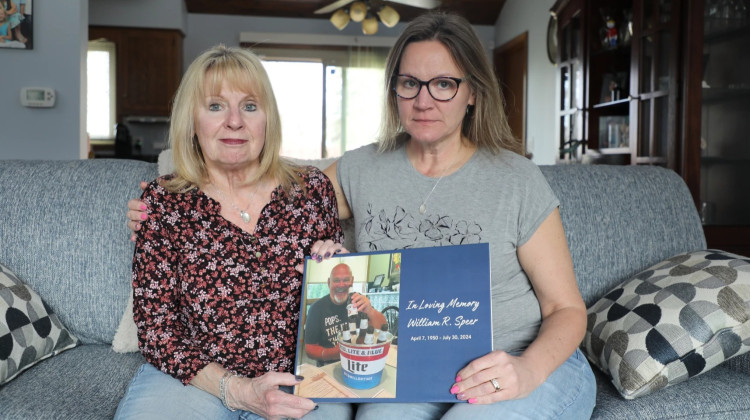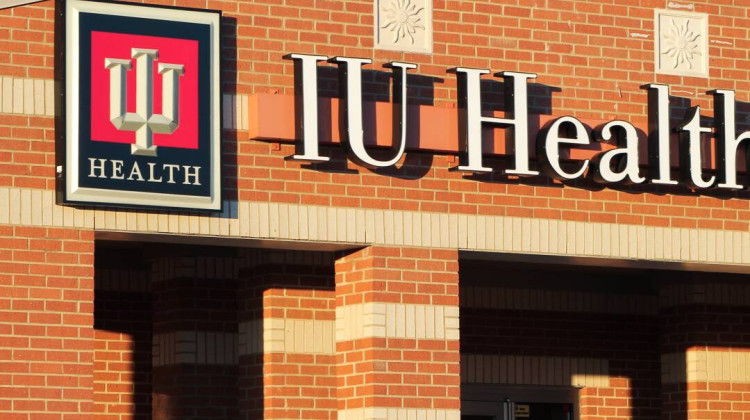
The amount of students who currently smoked cigarettes on one day during the 30 days before the survey was more than 6 percent in 2023 – higher than the 4.2 percent reported in 2021.
Lauren Chapman / IPB NewsA statewide survey for students conducted every other year monitors students’ health risks and behaviors in categories such as physical health, alcohol and tobacco use and unintended physical injury. The anonymous survey reports some concerning changes for Indiana youth since 2021.
Data from the Center for Disease Control and Prevention’s 2023 Youth Risk Behavior Survey showed some increases and decreases in risk behaviors. Lawmakers expressed concern over data points such as mental health and screen time.
Mental health
The report showed that almost 34 percent of students had mental health that was “not good” sometimes or all of the time. Almost half of students had felt sad or hopeless for almost every day two weeks in a row, and nearly a quarter of students had seriously considered attempting suicide.
State Sen. La Keisha Jackson (D-Indianapolis) expressed concerns about some of the mental health data points presented. She questioned whether there were positive solutions that could come from this data.
“If [the General Assembly] put more money into sports activities, recreation for youth, things to keep positive, legislation around social media, those things that permeate the causes of mental health issues for our youth, would that help start to mitigate some of the issues that they are having?” Jackson said.
State Health Commissioner Lindsay Weaver said there is some data in the report to help determine solutions.
“I think having this data to show that only 22 percent of our students say they get eight hours of sleep – and we know that that can drive problems with mental health. And that 76 percent of them are spending three or more hours on their cell phones, that does help us know – OK, where are some opportunities where we can help engage?” she said.
Weaver said responding to this data is a multifaceted approach, but that some potential solutions have shown promise in schools.
“The [school programs] that stand out to me are the ones that are really focus on connectedness, employability,” Weaver said. “So, really getting students to meet with each other, meet with not just their peers, but also adults. Talk about resiliency, talk about sleep. All these things that we're talking about here have seen positive outcomes.”
Injury and violence
The 2023 survey also showed a notable increase in students using social media, texting while driving and driving under the influence compared to 2021 data.
In 2023, almost 44 percent of students did not wear a seatbelt in a vehicle driven by someone else one or more times during the 30 days before the survey. This is compared to 41 percent in 2021. In 2023, almost 6 percent of students reported having driven a car or other vehicle while under the influence of alcohol at least once during the 30 days before the survey. This is compared to just 1 percent in 2021.
Weaver said the state can use this data to show what outreach to students has been neglected, and how to discourage these behaviors.
“Have we moved away from messaging enough about that?” she said. “And if so, that will go toward trauma and injury prevention to be able to take that on and say, let's pull out the playbook. What worked before to get people to use your seatbelts, and let's do it again.”
Kate Schedel is the director of maternal and child health programs at the Indiana Department of Health. She said students are also experiencing higher levels of community violence in the 2023 statistics compared to 2021.
“19.4 percent of our youth have experienced witnessing community-level violence,” she said. “This is up from 14.8 percent in 2021. And so we have more and more youth experiencing this community-level violence and witnessing that.”
More than 19 percent of students reported they had seen someone physically attacked, beaten, stabbed, or shot in their neighborhood. And more than 3 percent of students experienced unstable housing during the 30 days before the survey.
A new section of the survey for 2023 included rewritten questions about youth experiences with discrimination. More than one-third of Indiana students reported experiencing racial or ethnic discrimination. Nearly a quarter of LGBTQ+ students felt they were treated poorly because of their sexual or gender identities. And more than fifteen percent of LGBTQ+ students reported being threatened with a weapon on school property.
Physical health, alcohol and drugs
More than 40 percent of students reported their physical health in general was excellent or very good – down from more than 47 percent in 2021. About 22 percent of students reported getting more than eight hours of sleep per night – an increase from about 18 percent in 2021.
The amount of students who currently smoked cigarettes on one day during the 30 days before the survey was more than 6 percent in 2023 – higher than the 4.2 percent reported in 2021.
Vaping survey results were mixed. About the same amount of students in 2021 and 2023 reported currently smoking cigarettes or using electronic vaping products. However, more than 7 percent of students reported using vaping products frequently (on 20 or more days) in 2023 – up from 5.8 percent in 2021.
Weaver said especially for vaping and cigarette use among older age groups, it is important to engage peer support to discourage these behaviors.
“It's the youth groups saying ‘don't smoke, don't drink, wear your seatbelt,’” she said. “And so I think that's where our youth advisory board, we need to engage our youth to be a part of the solution here. And those especially in those older ages.”
Join the conversation and sign up for the Indiana Two-Way. Text "Indiana" to 765-275-1120. Your comments and questions in response to our weekly text help us find the answers you need on statewide issues.
Alcohol use for students increased in 2023. About 25 percent of students in 2023 had at least one drink of alcohol on one day during the 30 days before the survey, and about 12 percent of students were binge drinking. In 2021, 20.6 percent of students had at least one drink of alcohol on one day during the 30 days before the survey – and about 10.5 percent of students were binge drinking during the 30 days before the survey.
Despite these changes between 2021 and 2023, alcohol use and cigarette smoking among students has generally gotten better over the past 10 years, with current cigarette use dropping from nearly 19 percent to 6 percent, and alcohol use dropping from nearly 33 percent to 25 percent between 2011 and 2023.
Schedel said there are some statewide partners that help with deterring these behaviors.
“We do have several partners around the state that implement programming that is evidence-based that reduces risky behaviors and youth,” Schedel said.
The survey also included information on students’ sexual behaviors and contraceptive use, post-secondary plans, and extracurricular activities.
Officials said they are encouraged by the “silver lining” behind some declining risk behaviors, but are continuing to use this data to hone in on areas where extra support and community intervention is needed.
Violet is our daily news reporter. Contact her at vcomberwilen@wfyi.org or follow her on Twitter at @ComberWilen.
 DONATE
DONATE






 Support WFYI. We can't do it without you.
Support WFYI. We can't do it without you.